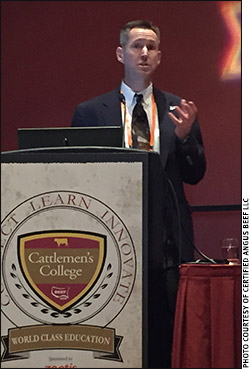Cattle Cycle:
Back From the Brink
There are more cows in the country now for the first time in 10 years, and some former drought states report up to 25% more replacement heifers. Does that mean the cattle cycle is in a sustainable expansion phase, or will it fizzle out like it did nine years ago? How long could it last, and what’s in store for cattle feeders?
 Pete Anderson, director of research for Midwest PMS, ventured some answers as he addressed producers at February’s Cattlemen’s College during the Cattle Industry Convention & NCBA Trade Show in San Antonio, Texas.
Pete Anderson, director of research for Midwest PMS, ventured some answers as he addressed producers at February’s Cattlemen’s College during the Cattle Industry Convention & NCBA Trade Show in San Antonio, Texas.
The slight recovery in beef cow numbers in 2004 was only a short reprieve (after drought) in a selloff that began in 1996. In two years, that short boom managed to add just 170,000 cows, but USDA reported cattlemen added more than 600,000 in a single year during 2014.
“Typically, it takes a little time to turn the battleship around,” Anderson said, “but all the liquidation and everything that happened to cow numbers since the 2007 peak was due to external factors. That brings to mind an important distinction between what we want to do and what we have to do.”
Runaway increases in input cost were followed by worsening drought.
“You threw a recession in on top of that, and a certain weakness in overall beef demand, and the liquidation just went on to where we’re much smaller as an industry than we ever intended to be,” Anderson said, noting that helps explain the spike bottom.
“We’ve never had this strong of a signal or this much incentive to expand,” he said, indicating two years of cow-calf enterprise profits of more than $500 per unit.
Producers wanted to expand for several years, as seen in the higher number of heifers kept for breeding since 2011, but many went back to be finished for beef because of those external factors that kept a lid on the cycle.
When the replacements finally hit the well-culled cow herd, they made up 19.5% of that herd, and appear headed for a second year above 19%.
“That’s a record by quite a bit,” Anderson said. “Back in the early 1990s that percentage never got above 18.5%. For the last six years, we’ve had elevated cow-culling rates, but now one man’s cull is another man’s new cow. They’re almost all keepers to somebody.”
Not all replacements enter the breeding herd, he noted, and the average is 85%, but last year 96% of heifers expected to calve actually entered the herd. Although there is no “definitive data,” Anderson said this is probably the youngest herd ever and is, therefore, poised for rapid expansion.
Returning to the line between what producers want to do and what they have to do, he noted persistent drought in several areas may limit the pace. Still, he said, 32 million beef cows is a near-term target for rebuilding. The industry and beef demand can sustain that level, partly because “again, we’re smaller than we ever intended to be.”
Bovine biology is the chief limitation now, Anderson said, noting cows don’t have litters, and every heifer kept is a one-for-one trade that takes away from the stocker and feeder market.
“Producer expectations play a huge role, and at the age of many herd owners today, generational transfer enters in and, with it, some difficult financing issues,” he said. “This is not just a cattle cycle of cows, but of producers.”
Noting 64% of cows are controlled by those either near or past retirement age, Anderson said, “It’s not a question of whether the generational turnover will happen, but how it’s going to happen. How smooth or disruptive that is will impact how quickly we can rebuild the cow herd.”
That’s all assuming beef demand, “a pleasant surprise in 2014,” can continue strong in the face of increasing pork and poultry supplies, he added. “I don’t see any fundamental changes, but we do have to continue to watch it because that’s a potential limit on how far we can push the expansion.”






